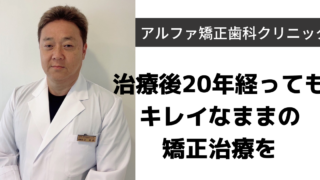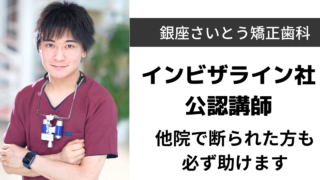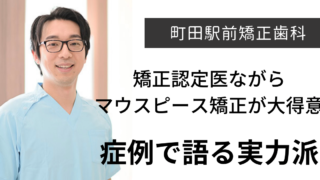Last updated on December 17, 2021
Orthodontic treatment increases the risk of tooth decay because food and dirt can easily accumulate on the device and brushing teeth becomes more difficult.
We will discuss the relationship between orthodontics and tooth decay, including whether it is possible to correct a cavity and what to do if a cavity develops during orthodontics.
Can I straighten my teeth even if I have cavities?
If there is a cavity, treatment of the cavity is basically prioritized over orthodontic treatment. HoweverIt does not necessarily mean that the cavity cannot be corrected until it is completely healed.
Whether a cavity can be corrected depends on how far the level of decay has progressed from one of the following three levels
- initial tooth decay
- moderate tooth decay
- Severe tooth decay
Moderate or severe decay is more urgent to treat and cannot be corrected until decay treatment is completed, but if the decay is in the early stages, before the tooth is perforated, orthodontic treatment may be initiated or continued.
However,The diagnosis regarding the progress of decay and the need for treatment depends on the dentist's judgment.
If cavities are found before or during orthodontic treatment, follow your dentist's instructions.
Does braces make me more susceptible to cavities?

During orthodontic treatment, food debris and stains are more likely to stick to the teeth and be difficult to remove, making them more susceptible to decay.
Food debris and tooth stains can cause tooth decay,The risk of tooth decay is inevitably high during orthodontic treatment for several years.
To prevent tooth decay, the following points should be kept in mind during orthodontic treatment
- Brush teeth properly after each meal
- Get guidance from your dentist about brushing your teeth during orthodontic treatment.
- Regular cavity checks at the dentist's office.
Brush teeth properly after each meal
Careful brushing is important to prevent cavities during orthodontic treatment.As much as possible, brush your teeth after each meal to keep your mouth clean.
In addition to a regular toothbrush, a one-tuft brush with smaller bristles can be used for fine areas such as uneven teeth and wire gaps.
If you are on the go and cannot brush your teeth, it is recommended to gargle with a mouthwash containing fluoride, which has cavity-preventive effects, and cetylpyridinium chloride, which has disinfecting effects.
Get guidance from your dentist about brushing your teeth during orthodontic treatment.
Brushing teeth during orthodontic treatment is more difficult and tricky than before orthodontic treatment.
If you brush your teeth in a self-styled way, you may not be able to remove stains correctly,You may want to get dental instruction at the dentist's office for orthodontics and cavity checks.
Regular cavity checks at the dentist's office.
The need for cavity treatment would interfere with the orthodontic plan.
If the orthodontic treatment is interrupted to treat cavities, the orthodontic period will be extended,Have your dentist check your teeth regularly for cavities and review your tooth brushing methods.
What to do if a cavity develops during orthodontic treatment
If a cavity develops during orthodontic treatment,
- Cavity treatment without removing orthodontic appliances.
- Partially discontinue orthodontic treatment
- Suspend all orthodontics and treat cavities.
This is the most common way to deal with the situation.
basicallyWe will determine how best to proceed with treatment based on the type of orthodontic appliance used and the location and condition of the cavity.
Cavity treatment without removing orthodontic appliances.
Depending on the condition and location of the cavity, it may be possible to treat the cavity while performing orthodontic treatment.
If all orthodontic treatment is interrupted to treat cavities, the orthodontic treatment will be prolonged because the teeth will not move during this time.
Therefore, to the extent possible, orthodontic treatment and cavity treatment are performed in parallel to avoid prolonging the treatment period as much as possible.
For wire orthodontics
- Cavities on chewing surfaces
- Cavities on teeth not covered by wires, etc.
If the cavity is in a site that does not interfere with such a wire,Orthodontics may be able to proceed as planned while treating cavities.
Mouthpiece orthodontics
If the cavity is a very small cavity that requires little removal and can be filled without interfering with the mouthpiece, treatment may proceed as planned.
However, mouthpiece orthodontics covers the entire tooth with a mouthpiece,Note that when performing cavity treatment that involves grinding teeth, it may be necessary to remake the mouthpiece regardless of the location of the cavity.
Partially discontinue orthodontic treatment
Orthodontic treatment may be interrupted by removing the appliance only in the decayed areas and continuing orthodontic treatment only in the healthy tooth areas.
By proceeding with treatment only in areas not related to cavities, the prolonged orthodontic period can be prevented as much as possible.
However, if removing the device at the site of decay does not allow the other teeth to benefit fully from the orthodontic treatment, the orthodontic treatment may have to be interrupted.
For wire orthodontics
- Cavities between teeth
- Dental caries on the tooth where the wire is attached, etc.
If cavities develop in these areas, the wires interfere with the cavity treatment.
Therefore,Wires are removed only in the areas that need cavity treatment, and the wires in other areas are left in place to continue orthodontic treatment.
After the cavity treatment is completed, the patient wears the wire again and returns to the overall orthodontic treatment.
Mouthpiece orthodontics
As in moderate to severe caries,If fillings or coverings significantly change the shape of the teeth, the mouthpiece may be cut only in areas that need cavity treatment to continue orthodontic treatment.
However, mouthpieces that have already been created will no longer be available,The mouthpiece will need to be remade after cavity treatment.
Suspend all orthodontics and treat cavities.
If there are numerous cavities, orthodontic treatment may be interrupted by removing all appliances, and priority may be given to cavity treatment.
For wire orthodontics
Remove all wires from teeth and treat cavities.During this time, orthodontic treatment is suspended.
After all cavity treatment is completed, wires are again placed on the teeth before orthodontic treatment is resumed.
Mouthpiece orthodontics
Discontinue use of the mouthpiece and treat the cavity.If mouthpiece orthodontic attachments are attached to the teeth, these should also be removed.
After all cavity treatments are completed, the mouthpiece will be made again and a treatment plan will be developed, and orthodontic treatment will resume.
Dental caries in orthodontic treatment.
If a cavity is found during orthodontic treatment, the following points should be noted
- Consult with an orthodontist first before treating cavities.
- Fillings and coverings are chosen with the idea of rebuilding them after orthodontic correction.
Consult with an orthodontist first before treating cavities.
If you need cavity treatment before or during orthodontic treatment, or during the maintenance period after completion of orthodontic treatment,Consult an orthodontist first.
Depending on the progress of cavity treatment,
- Pre-correction → Postponement of correction start date, change of correction plan
- During orthodontic treatment → interruption of orthodontic treatment, change of orthodontic plan
- After orthodontic treatment → make and heal the retention brace
and other measures will be necessary.
Especially if the orthodontist and the cavity dentist are different,Be aware that treating cavities before consulting an orthodontist can interfere with the improvement of dental alignment or cause a disruption of the beautifully aligned teeth.
Choose coverings and fillings with the idea of rebuilding them after orthodontic correction.
Cavity treatment to make a cavity covering before or during orthodontic treatment,The height and size of the bite and the coverings may not match after orthodontic treatment, and they may need to be remade.Also, if ceramic crowns are made during orthodontic treatment, it will be difficult to attach brackets and attachments.Once temporary teeth are made, they are completed after the completion of orthodontic treatment.Many teachers recommend that you do the same.
Ceramic and other highly esthetic covers and crowns, which are placed at one's own expense, are expensive.
Depending on how long it takes to complete the correction, it could be several months, or at the most, 1-3 years after the correction is complete, before it can be used,It is a good idea to choose the type of coverings and fillings with a view to rebuilding them.
365dentist for orthodontic consultation
Because orthodontic treatment can lead to cavities, you want to choose a dentist who will consider not only the alignment of your teeth but also the prevention of cavities.
- I'd hate to get cavities with braces...
- I want to straighten my teeth with a dentist who will also consider cavity prevention!
If you are saying,365dentist conveniently helps you choose an orthodontist online.It is.
The general questions areOpen ChatFor an individual dental selection consultation, please contactofficial linePlease contact us at
365dentist General Supervisor Dentist/Yukiko Katsuya
Graduated from Nagasaki University School of Dentistry, ~2018 Kyushu Medical Center, 2018-present Working at a dental clinic in Tokyo
Supervisor: Dentist/Naomi
After completing clinical training, worked in cosmetic dentistry in Tokyo. Currently a dentist and dental writer.


![Ikebukuro] Ikebukuro Orthodontic Clinic 2 Myogdsu Orthodontics-Kitahara.zip 14](https://365dentist.jp/wp-content/uploads/2024/02/茗水矯正歯科•北原.zip-14-320x180.png)
![Akihabara] Akihabara Orthodontics 3 cc21aaaf e747 48e7 918f a7537749e093](https://365dentist.jp/wp-content/uploads/2023/03/CC21AAAF-E747-48E7-918F-A7537749E093-320x180.jpg)
![Ginza] Ginza Orthodontics 4 茗水矯正歯科•北原.zip 9](https://365dentist.jp/wp-content/uploads/2024/04/茗水矯正歯科•北原.zip-9-320x180.png)
![Hamamatsucho] Maruyama Orthodontics 5 1b28b683 0b07 467a 8db3 c6f9c21b69f3](https://365dentist.jp/wp-content/uploads/2023/02/1B28B683-0B07-467A-8DB3-C6F9C21B69F3-320x180.png)



![Mejiro] Mejiro Dentistry & Orthodontics 9 Mejiro Icon](https://365dentist.jp/wp-content/uploads/2023/04/目白アイコン-320x180.jpg)

![Ikebukuro] Myozui Orthodontics, Kitahara 11 A9D63899 8BBF 4AC0 A512 781143AF8AE2](https://365dentist.jp/wp-content/uploads/2023/03/A9D63899-8BBF-4AC0-A512-781143AF8AE2-320x180.png)










Comment